From Dune to Cliff In a GMC Sierra
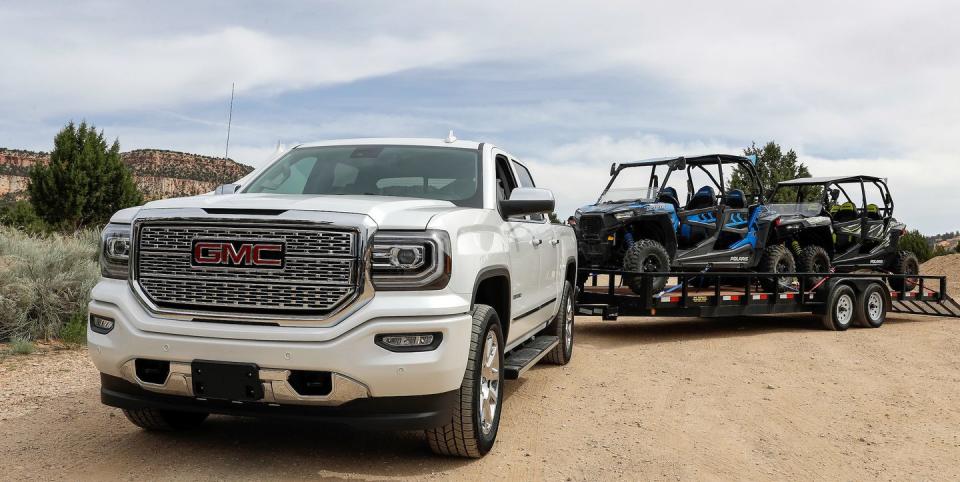
It was the season of the big boys, that hot boisterous month before the full brunt of summer, that heady thaw of the cold when out come the Harley-Davidsons, out come the motorboats and dirt bikes and all-terrain vehicles. Out there on the dunes the latter were jumping about, yelling and hooting with aplomb. Their shouts echoed across the valley. I watched them as they scaled the highest dune, scrambling atop the loose dry powder, nervously, precariously, slipping from the tracks honed by generations of boisterous off-roaders. Then they bounded back down to the pit below, arcing perfect parabolas across the hill. Their drivers shouted and whooped, though you couldn’t hear them over their 1000cc engines. They were so carefree and wild. This was their dominion.
These big toys for big boys necessitate a tow rig. The 2018 GMC Sierra Denali 1500 should do nicely. It is 9000 pounds of maximum towing potential, nearly three tons of chrome-laden luxury entered via three-way automatic power-retracting chrome running boards that ka-thunk with authority. It starts at $53,900. It proves that through electronics and pure strength of sheetmetal, nearly any towing difficulty can be eliminated: Crosswinds, stability control, trailer braking, mismatched tongue weight-notable but for the sheer amusement of the phrase “tongue weight.” The process has been democratized. Damn near anyone can tow.
Any moment now, the all-new 2019 Sierra 1500 will be unleashed-but for now, GMC was conducting a farewell tour of sorts for the outgoing model. Across Utah’s adventurous terrain, we brought side-by-side ATVs atop 22-foot trailers, pointed toward Zion National Park and the Coral Pink Sand Dunes where the loveable lads romp with abandon.
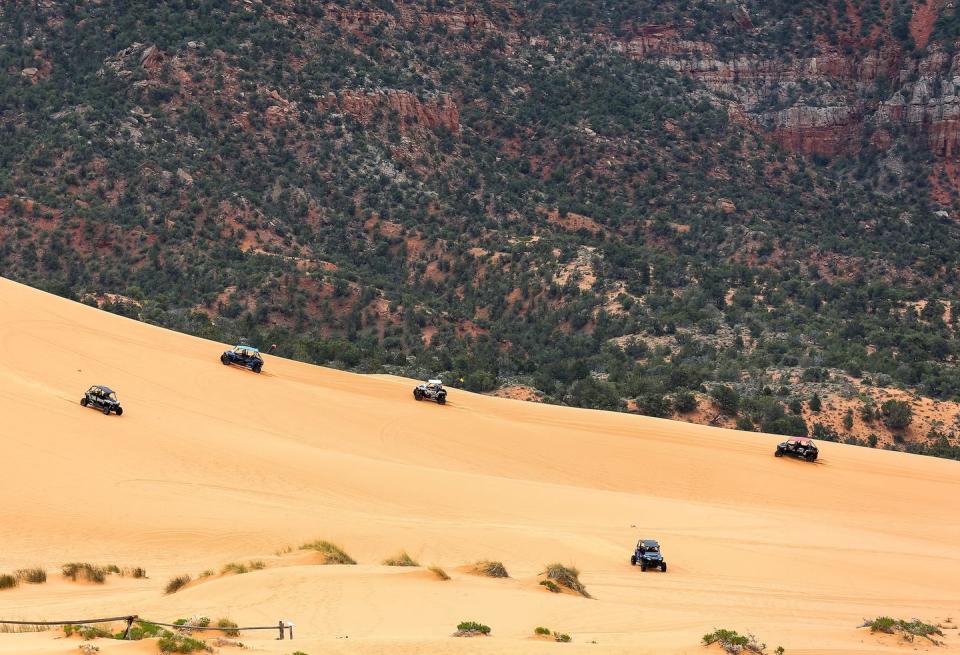
Southwestern Utah was a flawless blue sky, punctuated by curtains of rain above flat-topped mesas like an uncle’s buzz cut. It was sphinxlike rock formations the color of paint swirls, on the side of the freeways, topped with stringy plants. It was billboards for rehabilitation centers, strip malls, sand-colored roofs of housing developments rising over the crest of hills like umbrellas. I thought about the last time I had towed: 1400 miles from Los Angeles to Austin, a car trailer behind a 16-foot U-Haul box truck, across a similar vastness, topping out at 73mph in the blank West Texas canvas.
Here in the GMC, my driving partner Jonathon Klein recounted his first job, working for the Parks Department outside of Chicago: as a long-haired 16-year old, he had been evidently entrusted to haul 22,000 pounds of mowing equipment. “We played things fast and loose,” he said. “I used to have to think when I was towing. Now, I’m barely awake.”
“Well, hopefully not with us in here,” said a GMC representative, nervously, from the backseat.
“Oh, no, of course not,” Klein said.
When it was my turn to drive, I marveled. Smooth in a way befitting decades of refinement in the realm of the pickup truck, the 5.3-liter V8-producing a “mere” 355 horsepower-held momentum easily on uphill grades. When demanded, acceleration built steadily and surely, cool and collected. Truth be told, you used to need a 3500 Heavy Duty for this kind of towing detail-to get this kind of power out of a “base” engine is an achievement. Occasionally I added minimal steering correction for the errant crosswind. The steering was light, devoid of urgency. I checked the dashboard: We were cruising along at 75 miles per hour, and the truck felt vast but controllable, an effortless locomotive. We trucked along listening to the same ‘90s music Klein had rocked out to in his Parks Department gig back then: Blind Melon, Alice In Chains. Behind was 6000 pounds of dirt-stomping fury, which, properly tied down, made nary a peep. We eased toward the exit.
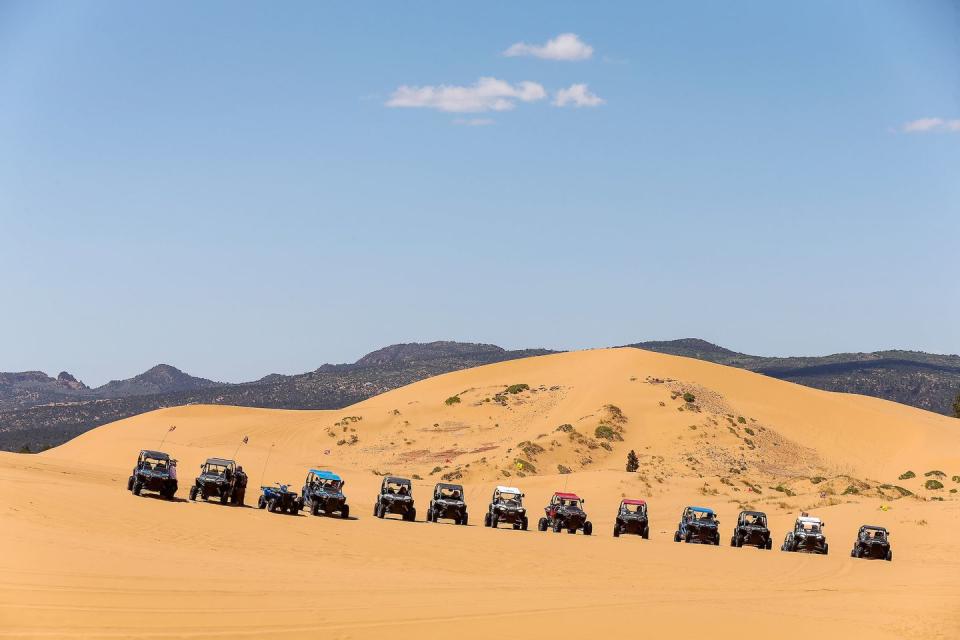
The Polaris RZRs featured beefy roll-cages, 1000cc engines with 75 horsepower, 13.5 inches of ground clearance and over a foot of suspension travel. They could reach 40mph in four seconds flat, which on sand felt like record-breaking speed. Tall and narrow, perched upon tiny black wheels, angry headlights and sneering plastic grille, the RZRs were shaped like raging goiters. For $10,299 you can bring a base-model RZR home, but our 1000cc-equipped big-blocks were closer to $18,000. “You know the Turbo 1000s,” Klein gushed, “they’ve got 168 horsepower. Sand is only fun when you’ve got, like, twelve hundred horsepower, a sandrail. Christ. Can you imagine?”
Beneath the paper-edged horizon of Vermillion Cliffs, the sand glowed rose gold, vivid and radiant, colors shifting with each footstep. From the south the wind picked up through a gap in the cliff, gaining speed through the notch, then slowing in the valley, and from the air fell the atom-like elements of entire cliffs, gathering and collecting like undulating waves.
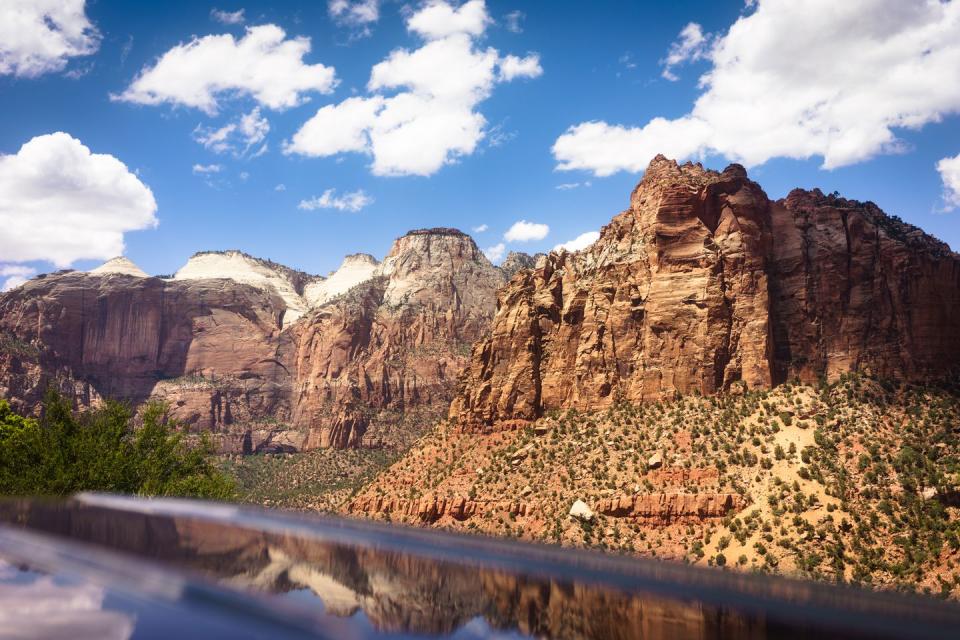
“Two people a year die in accidents here,” said Coby, our ATV guide, a native of San Diego, where this sort of thing is a national pastime. We took this information in stride. Then we put on our helmets and fired up the ATVs with a brap.
We followed Coby down a narrow trail, on the edge of the dunes, bordered on both sides by bushes of stringy plants. My RZR skittered over the loose surface, rattling deafeningly over washboards, occasionally slowing, the drag of the surface interrupting the way traction control does on a modern car. But as I sawed madly at the wheel I felt a sensation of floating, maybe even flying. We turned a corner and ran up blind hills, sun and sky filling our visors, and the suspension pulled close to the bumps, and I gassed it harder, breaking over the terrain, conquering nature. What lives under the surface, protesting its upstairs neighbors? Just point and shoot. When your speed breaks, just floor it and tell yourself over the bone-crunching washboards that this is normal, this is normal, and it rules.
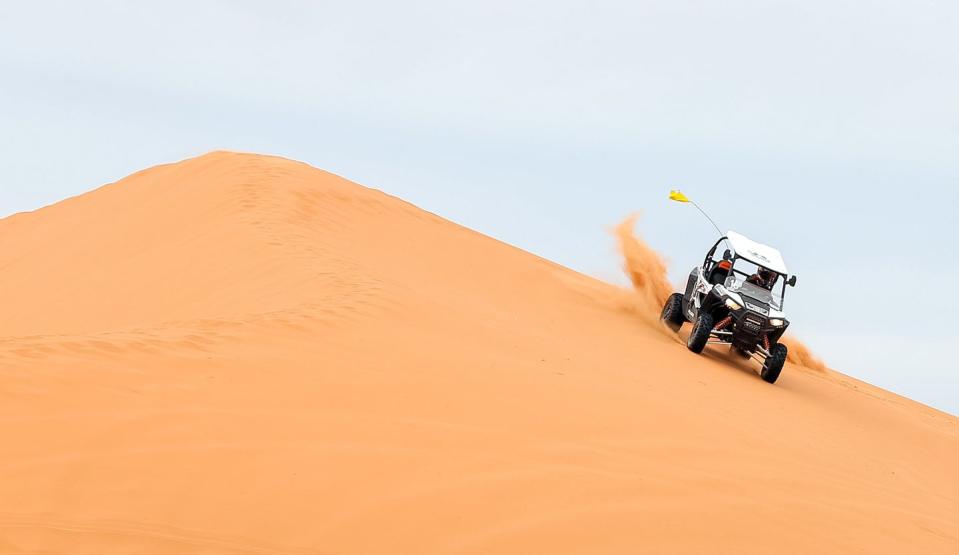
Into the basins now, down plunging dunes and back around in ever-widening arcs. I remembered Coby telling us: don’t slow down. Don’t stop. Otherwise you’ll sink. On Monday, they had to dig out an ATV that just hadn’t attacked hard enough.
It was worth remembering, cresting innocuous-seeming hills that suddenly dropped away from me, that I hate roller coasters.
We reached the highest point in the park, Star Dune, a soaring rise atop a basin that we nervous amateurs would now try to summit. Naturally, a traffic jam formed. I watched as the two ATVs before me clawed for grip, gravity outgunning their engines, and just as they reached the apex of their climb they began to slide sideways, their rears digging sharply right-and now myself, fearing a rollover, the ground slipping out from under me, being pulled downward in two different directions…
But we made it ungracefully to the peak of the dune, then turned and dropped back down, into the hidden places. I stopped in that vast and undulating basin, and watched the Polarises roam free, screaming up the slopes, steering somewhat too close to those who had parked to take in the view. Sand is tricky: Too hot and the grains dry out, scattering, too cold and the ground bogs you down. I was glad that I didn’t faceplant, or die, or worse, embarrass myself in front of Coby.
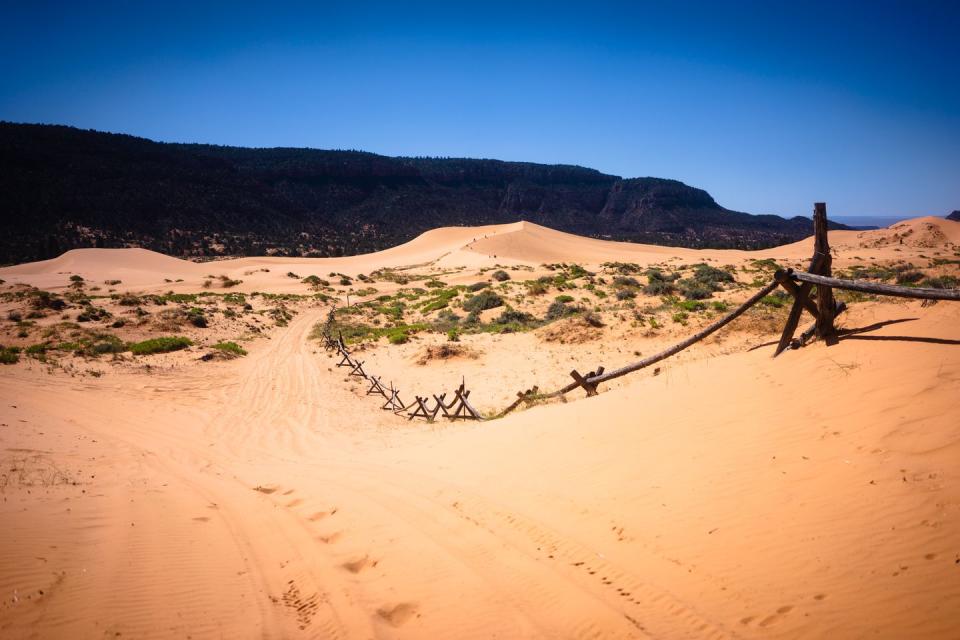
The nice folks at GMC unhitched the now-empty trailers from our Sierras. They bade us farewell as we followed Highway 9 toward Zion National Park, about 30 miles northwest. Now in a Sierra Denali with a 6.2-liter V8, with 420 horsepower, the larger engine felt even smoother and more refined.
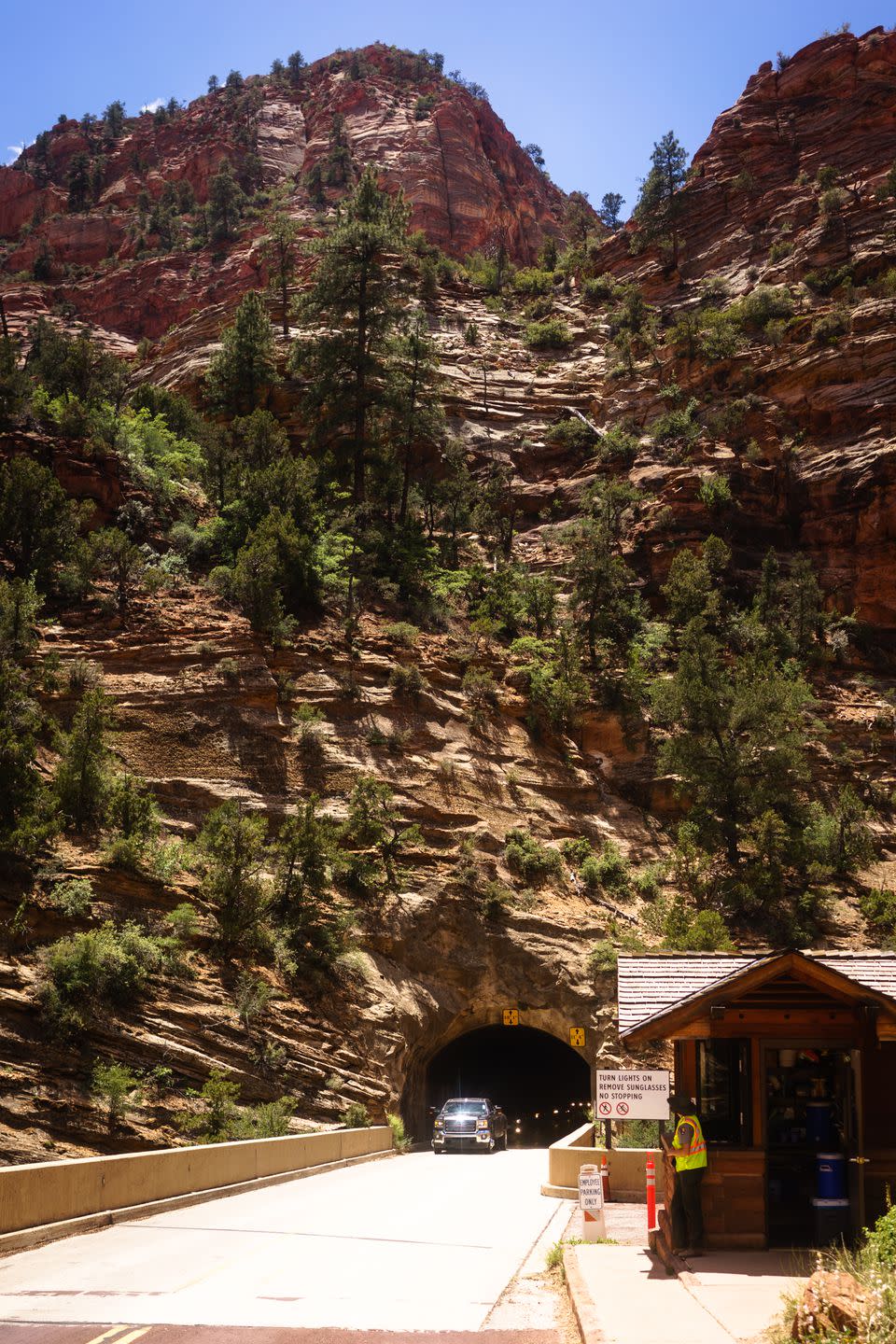
Zion unfolded like a plunge into deep ocean: From the flatness of a shoreline into a deep and alien valley. Highway 9 cut across the lower half of Zion, winding and narrow, and RVs and Harleys passed us as we drove past egg-white checkerboard mesas, crisscrossed with grooves; past rings of sandstone, smoothed as if on a potter’s wheel, close enough that I felt like I could touch them. In the faraway distance were painted towers, otherworldly formations rising and then soaring above, casting shadows upon each other. Their textures resembled distressed wood. No wonder the Mormons followed Brigham Young through here, I thought: It would be hard not to find religion when surrounded by so many naturally-formed cathedrals.
We paused before the entrance of a tunnel, cut into a skyscraper-like cliff. Built at the start of the Depression, the Zion-Mt. Carmel Tunnel was a feat of engineering: One of the longest tunnels in America, burrowing more than a mile into the earth, following the contours of the Pine Creek Canyon. Engineers spent three years blasting through the rock from the center outward. When it was finally completed in 1930, it opened the park to a generation of sightseers in Model Ts, a marvel cut through solid rock
Inside the tunnel, as we descended lower, there was only the eerie glow of headlights bouncing off the ribbed ceiling. We turned with the canyon. Occasionally a light would shine from the tunnel’s northern side, but it was not the end: Instead, it was these great big holes cut into the rock face, the tunnel’s galleries, an unfurled window bringing light and air in a stuffy room. I snatched glimpses of banded rocks, a steep drop below. Exactly 1.1 miles later the tunnel ended at a gulch, below cliffs the color of paprika, overlooking a set of hairpin turns. Tourists milled about: Frat guys in Red Sox T-shirts, Chinese retirees in nylon windbreakers. Above the brush and the steep drop and the canyon below I saw cars passing across these galleries. Halfway up the rock was the tunnel, a long and slinking tendril cut into the cliff.
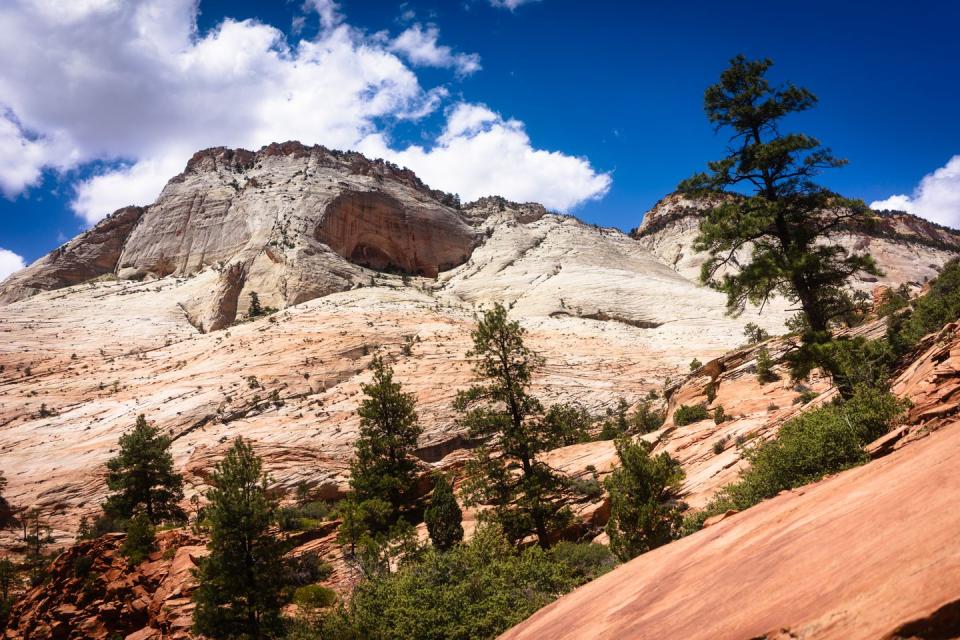
At the visitor center, an informational plaque overlooking the site of a long-abandoned ranch said: “History becomes a double-exposure, an overlay on the present-day scene.”
That line followed me across three Delta flights to the other side of the country. The west has been all but tamed, its wild dominion heeled: What was once dangerous is now accessible to man, woman, or rambunctious child alike. Our narratives layer upon themselves as if deposited by southern winds. Was it ever dangerous? Can it still be dangerous?
The few times I’ve ever towed anything, my mind conjured nightmares: Trailers flipping over, stuff flying off, reversing. Mayhem! I should be thankful that it’s easier than ever. So, too, the idea of returning: Someday I’d be back, hiking through the sandstone, setting up camp at the foot of Angels Landing. Another time. Because one of the beauties of modern travel is knowing that you can always return, someday.
You Might Also Like

 Yahoo Autos
Yahoo Autos 